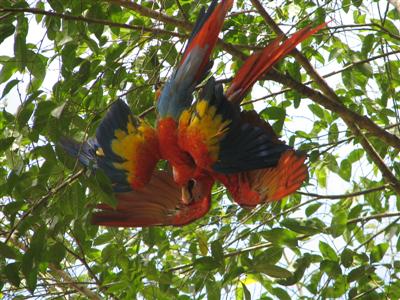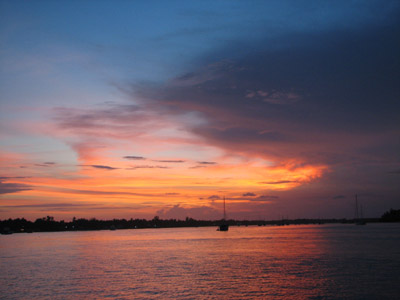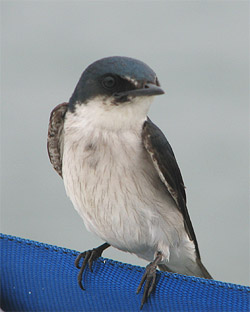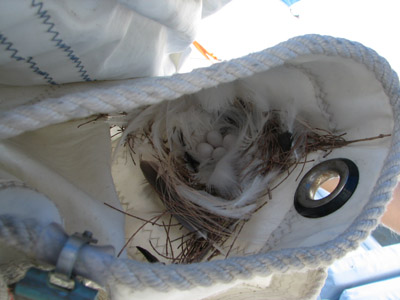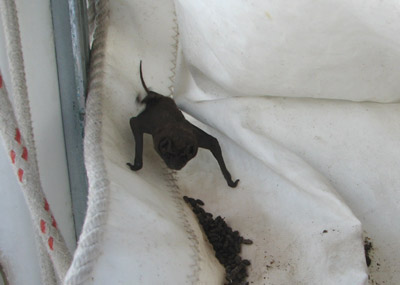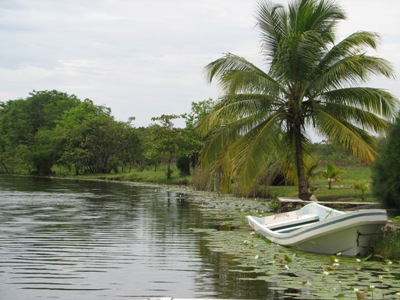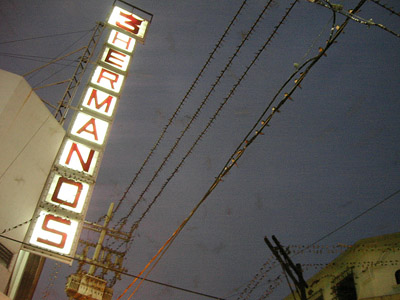
We planned on anchoring in Bahia Sacrificios, the northernmost bay of the Bahias de Hualtulco, and headed in under sail. Wind was out of the west and there was a fair bit of wind chop and swell built up from a sprightly week of strong steady wind; we used the binoculars to try to see if the anchorage was going to be protected. Unfortunately, our view of the water condition inside was obstructed by the startling profusion of pangas zipping around for no apparent reason, banana boats being pulled around loaded with shrieking vacationers, party boats tied up at all the mooring balls, swimmers, snorkelers, pumping disco music, etc. Whoa. In an attempt to give the place the fair side of doubt, we navigated the supposed underwater rocks and the many out-of-water rocky reefy areas and went in to see it in person. Our engine decided that now would be a prime opportunity to not start but there was really so much chop it probably would have driven us crazy with the cavitation anyway (sour grapes). Velella were also on their way into the bays but had wisely chosen a less popular location to set anchor; they reported being amused and not particularly surprised to see us sail right back out the opening not five minutes after entering. We followed them into the next anchorage, thinking that whichever anchorage Velella chose, we would take the other fork of the inlet since according to the chart/drawing/blobby excuse for a map/“not for navigational purposes†and watch out for the underwater reefs, there were twin bays separated by a “knife edge rock structure.†As we approached the second anchorage, we couldn’t see any twin bay inlets, nor did we see any rocky landscaping that could be described as “knife edge.†Perhaps it was high tide? We could see Velella anchored in a bay that had a long lovely and deserted beach and since they were way over on the left, we figured we’d just head in there and anchor on the right. To make a boring episode at the very least one fantastic run-on sentence, half the anchorage or more was coral reef and the wind died on us, making it difficult to maneuver, not to mention the sun was going down, and we just basically dropped anchor on Velella’s stern and still our ass was dangling over a crackling coral bed and so Joshua snorkeled around in the dwindling light scouting the bottom situation while I swam over to chat with Cameron and Jenny, who informed me of their recent sea snake sighting just off Sacrificios (deadly poisonous and, my god, a SNAKE! that swims in the water with you! there are few things more terrifying) with a prelude of “should we tell her?†but of course they then had to tell me because who leads up to something like that and doesn’t tell you, but Joshua was back at the boat and ready to re-anchor so I bravely swam the treacherous 50 meters back to help but remember that the motor was on a not-starting-jag so we decided that Joshua would swim out with the other anchor (I neglected to mention the snake thing until later), drop it, hoist it in and repeat with the second anchor thereby clawing our way over to a more desirable location, which seemed to work fine and the sun went down and it was calm calm calm. And quiet.
We never really figured out which bay we were in after all; possibly Jicaral. We even kayaked a couple of bays over and still couldn’t reconcile what we were seeing with any of the maps we possessed. And neither could Velella; the moment we entered the bay and were in shouting distance, they called over, “Where the hell are we?†Oh well, wherever we were, it was amazingly quiet and the first calm deserted anchorage we’d seen since the Sea of Cortez. We stayed there three nights hanging out in the quiet and working on various boat projects. During the day, pangas loaded with lifejacket-wearing passengers would buzz the place, we’d get videotaped by no less than half the tourists aboard, videos that would surely be enjoyed for years to come by the entire family, and they would take off for the next exotic local (Sacrificios! Banana boats and pumping music!!). Saturday, however, saw the arrival of two double-decker party boats who anchored startlingly near us and ferried hundreds of passengers to shore. When they busted out “Pump Up the Jam†(I kid you not) and blasted it at top volume, we decided we’d overstayed our welcome and headed down the coast to the next little bay, Chachacual or La India (or both?), another very lovely deserted beach that saw only daytime tourist activity in the form of snorkeling party boaters. This anchorage was bumpier but the visibility was good in some areas; we spent quite a bit of time snorkeling. No sea snakes sighted, although one striped eel had me close to leaping straight out of the water and doing some kind of fantastic dry flipper sprint to the nearest rocky outcropping until it was calmly identified by Jenny, who after all is a biologist and should know. After another couple of days, the scouter bees pegged our boat as a free water source and we had to leave before the masses were alerted and a full-scale invasion of our galley and takeover of the dish sponge was attempted. We took no less than five hours to go the five miles to Huatulco/Santa Cruz anchorage (where we are now). At one point while changing the jib, we started going backwards in the current. A highlight of the trip, surely, far outweighing even the turtle sex.
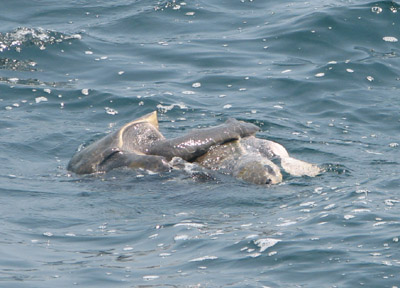
Yes folks, that is turtle sex. We almost hit them.
We arrived with crabby dispositions and dripping in sweat to anchor in dead coral/sandy weirdness while being circled by the navy in their gray power panga.
I think they entertained the idea that they could maybe come alongside before we actually had the hook down but one look at the madness in our eyes was enough to convince them to idle around until we were stopped. If that wasn’t fun enough, I managed to snap the throttle control off the remote control box for the motor, making the motor race loudly and my nerves singe. The moment we got the anchor set, or mostly set, the navy boat full of heavily armed navy boys and one panting black lab tied alongside and boarded. Despite their alarming appearances, they were very polite and the three or four left in the boat spent the majority of their time fending off the panga from the side of our boat. One talkative one was less formally attired (the rest of them wore black navy outfits) and he wandered around in bare feet asking all sorts of questions about where we were from and how long we’d been married and when we planned to have kids. They spent some time filling out detailed paperwork and then asked if we minded if they brought the dog aboard to search for drugs. (As if we had a choice) We said no problem and they called the dog to hop onto our boat. Dog was not having a bit of it and had to be lifted onto deck where he tottered unstably with his toenails clicking and sort of stood quaking until the operator told him to go below and sniff out the drugs. Clearly fearing the companionway entry, the dog had to be carried below where he presumably spent his time searching for scraps of cheese under the floorboards. Dog declared our boat a hopeless void of interesting smells and the navy handler carried him back to the panga where he promptly crawled into a dark corner to lie down. “Bon Voyage!†they shouted and charged back to their dock at top throttle.
Anyway, so now we’re anchored in Hualtulco, just off the canned city of perfect weirdness. Cruise ship number four is on its way in as we speak. We talked to a guy from one of the ships the other day and he said the trip was fourteen days; they started in Florida, went through the canal, and they usually had around six hours per stop. The next stop would be Puerto Vallarta, then onto Cabo San Lucas, finally to San Diego. What a strange impression one would have of Mexico if these were the only stops. After the cruise ships dock, there is a period of announcements, then the fearless explorer types emerge in twos or threes and take off down the dock. A period of relative inactivity follows, perhaps a few more stragglers wandering about, and we start to wonder if there really could be so few people aboard.Then it all happens at once. Crowds of hundreds move off in thick pastel packs fronted by prudently attired women holding neon orange or yellow flags aloft. The mescal factory tour, the Crucecita tour, the party boat/esnorkling expedition; after about seven of these groups leave, the rest trickle out in threes or fives, presumably to spend their precious time under a palapa drinking mescal concoctions before heading off to do a little souvenir shopping.
Evidently there used to be an actual fishing village where Hualtulco/Santa Cruz (never did get it straight which name was correct) is now. They razed the village to make space for “Paradise Found!â€â€”a conglomeration of hotels and restaurants and shopping malls–and moved all inhabitants over to Crucecita, a small town built from scratch to provide housing for the workers who supported the resort industry. Crucecita is pretty posh for a small Mexican village really; the sort of place where the central Mercado has perhaps two or three fruit stands and the rest is full of huipils and shot glasses with “Huatalco!†on them. There is, however, a really excellent church here that was only built in 2000 and which has a ginormous Virgin of Guadalupe painted on the ceiling. (I’ll post images later.) We did figure out where the vegetables could be purchased and did our veggie/dry goods/coconugs restocking. Then we did the paperwork to check out of the country and here we are, officially exited from Mexico yet still anchored in Huatulco with a week yet before we’ll get to El Salvador.
Irritatingly, Don the Weather Guy has abandoned the gulf of Tehuantepec and stopped forecasting windows altogether. I don’t know why but we’ve heard nothing for months except lengthy descriptions of how nasty the gulf weather is and how tricky it is to forecast a window (it takes a couple of days to get across) and now here we are wanting to know what the weather will be like and he’s no help. So we’ll just have to listen to the weather in Spanish on the VHF and hope for the best. We’re going to town now to try to make sense of the NOAA charts. The weather is typically mild this time of the year so at least we have that in favor.
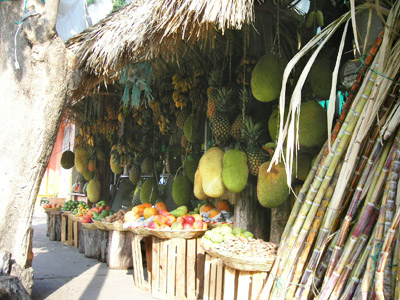
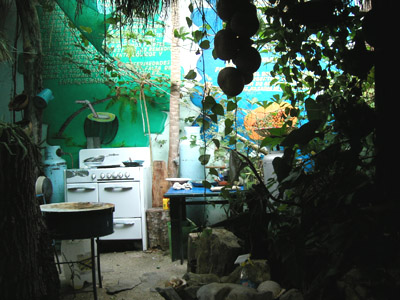
This is a café/juice bar we found in Crucecita that had very good ‘horchata de coco,’ a drink that appears to be coconut milk, cow milk, maybe some sugar and I’m not sure what else if anything.
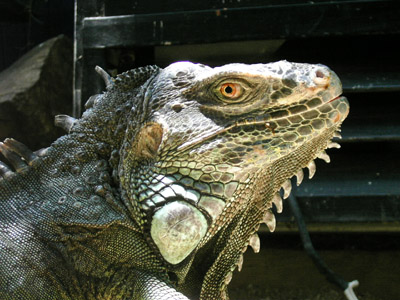
There was a large iguana running around getting into things.
